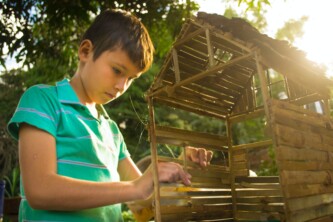Bamboo is gaining recognition as a viable material for construction due to its strength, versatility, and green credentials. Bamboo plants, like trees, absorb carbon dioxide as they grow, making them effective carbon sinks. In fact, a bamboo plantation can store more carbon per hectare than many tree species. Additionally, bamboo is one of the fastest-growing plants on Earth, with some varieties growing up to one meter per day. Unlike most trees, bamboo regrows after harvesting, making it a sustainable choice for construction.
While bamboo has a long history of use in construction in Asia, it remains a niche building material in Europe and the US. One of the reasons for this is a lack of familiarity and engineering expertise. However, demand for bamboo is increasing, and more companies are starting to develop bamboo structures. In Europe, the initial cost of using bamboo may be higher, but as its usage becomes more widespread, the cost is expected to decrease.
One challenge in Europe is the limited availability of larger bamboo species that do not grow well in colder climates. However, BambooLogic, the first large-scale bamboo grower in Europe, is working to change that. They are growing bamboo in the south of Portugal, where there is ample sunlight and the potential to restore degraded soil. The lack of standardization is another obstacle in Europe, as there is less data available compared to Asia. However, efforts are being made to develop international standards for bamboo construction materials.
In California, sustainable building materials company BamCore offers a panelized framing system made of engineered bamboo and wood. These panels are used to construct buildings up to five stories high. The company has gained traction with both individual homebuyers and developers looking for sustainable options. In the US, the largest homebuilder, D.R. Horton, is piloting BamCore’s bamboo product in several developments.
Overall, bamboo has the potential to be a significant player in the construction industry due to its strength, sustainability, and versatility. As more research and standardization efforts are made, bamboo is expected to become a more widely used and cost-effective building material.
Original news source: Can bamboo be big in construction? (BBC)
Listen
Slow
Normal
Fast
Group or Classroom Activities
Warm-up Activities:
– News Summary
Instructions: Divide the class into small groups. Give each group a few minutes to read the article. Then, ask each group to summarize the main points of the article in a brief news summary. They should focus on the key facts and ideas presented in the article. After a few minutes, have each group share their news summary with the class.
– Opinion Poll
Instructions: In pairs, students should discuss their opinions about the use of bamboo as a construction material. They can discuss its benefits, drawbacks, and potential impact on the construction industry. After the discussion, conduct an opinion poll by asking each student to share their opinion and reasons with the class. Encourage students to provide evidence or examples to support their opinions.
– Vocabulary Pictionary
Instructions: Choose 10-15 vocabulary words from the article related to bamboo and construction. Write each word on a separate piece of paper. Divide the class into small groups. Give each group a set of vocabulary words. One student from each group should pick a word and draw a picture representing that word. The other members of the group should guess the word based on the drawing. The group that guesses the most words correctly wins.
– Pros and Cons
Instructions: Divide the class into two groups. Assign one group to discuss the pros of using bamboo as a construction material and the other group to discuss the cons. Give the groups a few minutes to brainstorm and write down their points. Then, have each group share their arguments with the class. Encourage students to provide examples and evidence to support their points.
– Future Predictions
Instructions: In pairs, students should discuss and make predictions about the future of bamboo as a construction material. They can consider factors such as technology advancements, environmental concerns, and industry trends. After the discussion, ask each pair to share their predictions with the class. Encourage students to explain their reasoning behind their predictions.
Comprehension Questions:
1. What are the advantages of using bamboo as a construction material?
2. How does bamboo contribute to carbon sequestration?
3. Why is bamboo not widely used in construction in Europe and the US?
4. What is one challenge in Europe regarding the availability of bamboo?
5. How is BambooLogic working to address the limited availability of larger bamboo species in Europe?
6. What is one obstacle to using bamboo as a construction material in Europe?
7. What sustainable building materials company in California offers a panelized framing system made of bamboo?
8. How is D.R. Horton, the largest homebuilder in the US, incorporating bamboo into their developments?
Go to answers ⇩
Listen and Fill in the Gaps:
Bamboo is gaining recognition as a viable material for construction due to its strength, versatility, and green credentials. Bamboo (1)______, like trees, absorb carbon dioxide as they grow, (2)______ them effective carbon (3)______. In fact, a (4)______ plantation can store more carbon per hectare than many tree species. Additionally, bamboo is one of the fastest-growing plants on Earth, with some varieties growing up to one meter per day. Unlike most trees, bamboo regrows after harvesting, making it a sustainable choice for construction.
While bamboo has a long history of use in construction in Asia, it remains a niche building material in (5)______ and the US. One of the reasons for this is a lack of familiarity and engineering expertise. However, demand for bamboo is increasing, and more companies are starting to develop bamboo structures. In Europe, the initial cost of using bamboo may be (6)______, but as its usage (7)______ more widespread, the cost is expected to decrease.
One challenge in Europe is the (8)______ availability of larger bamboo species that do not grow well in colder climates. However, BambooLogic, the first large-scale bamboo grower in Europe, is working to change that. They are growing bamboo in the south of Portugal, where there is ample sunlight and the potential to restore degraded soil. The lack of (9)______ is another obstacle in Europe, as there is less data available compared to Asia. However, efforts are being made to develop international (10)______ for bamboo construction materials.
In California, sustainable building materials company (11)______ offers a panelized framing system made of engineered bamboo and wood. These (12)______ are used to construct buildings up to five stories high. The company has gained traction with both individual homebuyers and (13)______ looking for sustainable options. In the US, the largest homebuilder, D.R. Horton, is piloting BamCore’s bamboo product in several developments.
Overall, bamboo has the potential to be a significant (14)______ in the construction (15)______ due to its strength, sustainability, and versatility. As more research and standardization (16)______ are made, bamboo is expected to become a more widely used and cost-effective building material.
Go to answers ⇩
Discussion Questions:
Students can ask a partner these questions, or discuss them as a group.
1. What is your opinion on using bamboo as a construction material?
2. How would you feel if your country started using bamboo more widely in construction?
3. Do you think bamboo could be a solution for reducing carbon emissions in the construction industry? Why or why not?
4. Have you ever seen or lived in a building made of bamboo? If so, what was your experience like?
5. What are some advantages of using bamboo as a building material compared to traditional materials like wood or concrete?
6. How do you think the construction industry could benefit from using more sustainable materials like bamboo?
7. Do you like the idea of living in a bamboo house? Why or why not?
8. What challenges do you think bamboo construction faces in your country?
9. Have you ever heard of any other alternative building materials? How does bamboo compare to them?
10. Do you think bamboo construction could become mainstream in the future? Why or why not?
11. How do you think the perception of bamboo as a construction material differs between Asia and Europe/U.S.?
12. What are some potential drawbacks or limitations of using bamboo in construction?
13. Have you ever used bamboo products in your daily life? How do you feel about them?
14. How do you think the availability of bamboo construction materials could be improved in colder climates?
15. Do you think the cost of bamboo construction will decrease significantly in the future? Why or why not?
Individual Activities
Vocabulary Meanings:
Match each word to its meaning.
Words:
1. bamboo
2. construction
3. carbon dioxide
4. sustainable
5. Europe
6. standardization
7. buildings
8. material
Meanings:
(a) A gas that is absorbed by plants
(b) Structures used for various purposes
(c) The act of establishing a set of rules or guidelines
(d) A type of plant used for construction
(e) A continent that includes countries like France and Germany
(f) Able to be maintained or continued over time
(g) Substance used to make or create something
(h) The process of building something
Go to answers ⇩
Multiple Choice Questions:
1. What is one of the reasons why bamboo is gaining recognition as a viable material for construction?
(a) It is cheap and readily available.
(b) It is the fastest-growing plant on Earth.
(c) It is resistant to pests and diseases.
(d) It absorbs carbon dioxide and is a carbon sink.
2. Why is bamboo a sustainable choice for construction?
(a) It is resistant to fire and water damage.
(b) It regrows after harvesting.
(c) It is lightweight and easy to transport.
(d) It requires minimal maintenance and repairs.
3. Why is bamboo still a niche building material in Europe and the US?
(a) High initial cost compared to other materials.
(b) Limited availability of larger bamboo species.
(c) Lack of demand and interest from consumers.
(d) Lack of familiarity and engineering expertise.
4. What is one challenge in Europe regarding the use of bamboo in construction?
(a) Lack of standardization and data.
(b) High cost compared to other materials.
(c) Limited availability of larger bamboo species.
(d) Lack of interest and demand from consumers.
5. What is BambooLogic doing to promote the use of bamboo in Europe?
(a) Growing bamboo in Portugal and restoring degraded soil.
(b) Developing international standards for bamboo construction materials.
(c) Offering panelized framing systems made of engineered bamboo and wood.
(d) Educating consumers and builders about the benefits of bamboo.
6. What sustainable building materials company offers a panelized framing system made of engineered bamboo and wood?
(a) BamCore
(b) BambooLogic
(c) D.R. Horton
(d) Bamboo Construction Solutions
7. Who is piloting BamCore’s bamboo product in several developments?
(a) BambooLogic
(b) BamCore
(c) D.R. Horton
(d) Bamboo Construction Solutions
8. What is the potential for bamboo in the construction industry?
(a) It is expected to remain a niche material with limited usage.
(b) It has the potential to be a significant player due to its strength, sustainability, and versatility.
(c) It is not a viable option for construction due to its limited availability.
(d) It is only suitable for small-scale projects and not for larger buildings.
Go to answers ⇩
True or False Questions:
1. BambooLogic, a large-scale bamboo grower in Europe, is not working to grow bamboo in Portugal due to the limited availability of larger bamboo species in colder climates.
2. Efforts are being made to develop international standards for bamboo construction materials.
3. Bamboo regrows after harvesting, making it a sustainable choice for construction.
4. Bamboo cannot store more carbon per hectare than many tree species.
5. Bamboo plants absorb carbon dioxide as they grow, making them effective carbon sinks.
6. Bamboo has a short history of use in construction in Asia, and is a commonly used building material in Europe and the US.
7. The initial cost of using bamboo in Europe may not be higher, and it is not expected to decrease as its usage becomes more widespread.
8. Bamboo is one of the fastest-growing plants on Earth, with some varieties growing up to one meter per day.
Go to answers ⇩
Write a Summary:
Write a summary of this news article in two sentences.
Check your writing now with the best free AI for English writing!
Writing Questions:
Answer the following questions. Write as much as you can for each answer.
Check your answers with our free English writing assistant!
1. What are the advantages of using bamboo as a construction material?
2. Why is bamboo still considered a niche building material in Europe and the US?
3. What challenges does Europe face in using bamboo for construction?
4. How is BambooLogic working to overcome the limited availability of larger bamboo species in Europe?
5. How has BamCore gained traction in the US construction industry?
Answers
Comprehension Question Answers:
1. The advantages of using bamboo as a construction material include its strength, versatility, and green credentials. Bamboo plants absorb carbon dioxide as they grow, making them effective carbon sinks. Bamboo is also one of the fastest-growing plants on Earth and regrows after harvesting, making it a sustainable choice for construction.
2. Bamboo contributes to carbon sequestration by absorbing carbon dioxide as it grows. Bamboo plantations can store more carbon per hectare than many tree species.
3. Bamboo is not widely used in construction in Europe and the US due to a lack of familiarity and engineering expertise. Additionally, there is limited availability of larger bamboo species that do not grow well in colder climates. Lack of standardization and less data available compared to Asia are also obstacles.
4. One challenge in Europe regarding the availability of bamboo is the limited availability of larger bamboo species that do not grow well in colder climates.
5. BambooLogic is addressing the limited availability of larger bamboo species in Europe by growing bamboo in the south of Portugal, where there is ample sunlight and the potential to restore degraded soil.
6. One obstacle to using bamboo as a construction material in Europe is the lack of standardization and less data available compared to Asia.
7. The sustainable building materials company in California that offers a panelized framing system made of bamboo is BamCore.
8. D.R. Horton, the largest homebuilder in the US, is incorporating bamboo into their developments by piloting BamCore’s bamboo product in several developments.
Go back to questions ⇧
Listen and Fill in the Gaps Answers:
(1) plants
(2) making
(3) sinks
(4) bamboo
(5) Europe
(6) higher
(7) becomes
(8) limited
(9) standardization
(10) standards
(11) BamCore
(12) panels
(13) developers
(14) player
(15) industry
(16) efforts
Go back to questions ⇧
Vocabulary Meanings Answers:
1. bamboo
Answer: (d) A type of plant used for construction
2. construction
Answer: (h) The process of building something
3. carbon dioxide
Answer: (a) A gas that is absorbed by plants
4. sustainable
Answer: (f) Able to be maintained or continued over time
5. Europe
Answer: (e) A continent that includes countries like France and Germany
6. standardization
Answer: (c) The act of establishing a set of rules or guidelines
7. buildings
Answer: (b) Structures used for various purposes
8. material
Answer: (g) Substance used to make or create something
Go back to questions ⇧
Multiple Choice Answers:
1. What is one of the reasons why bamboo is gaining recognition as a viable material for construction?
Answer: (d) It absorbs carbon dioxide and is a carbon sink.
2. Why is bamboo a sustainable choice for construction?
Answer: (b) It regrows after harvesting.
3. Why is bamboo still a niche building material in Europe and the US?
Answer: (d) Lack of familiarity and engineering expertise.
4. What is one challenge in Europe regarding the use of bamboo in construction?
Answer: (c) Limited availability of larger bamboo species.
5. What is BambooLogic doing to promote the use of bamboo in Europe?
Answer: (a) Growing bamboo in Portugal and restoring degraded soil.
6. What sustainable building materials company offers a panelized framing system made of engineered bamboo and wood?
Answer: (a) BamCore
7. Who is piloting BamCore’s bamboo product in several developments?
Answer: (c) D.R. Horton
8. What is the potential for bamboo in the construction industry?
Answer: (b) It has the potential to be a significant player due to its strength, sustainability, and versatility.
Go back to questions ⇧
True or False Answers:
1. BambooLogic, a large-scale bamboo grower in Europe, is not working to grow bamboo in Portugal due to the limited availability of larger bamboo species in colder climates. (Answer: False)
2. Efforts are being made to develop international standards for bamboo construction materials. (Answer: True)
3. Bamboo regrows after harvesting, making it a sustainable choice for construction. (Answer: True)
4. Bamboo cannot store more carbon per hectare than many tree species. (Answer: False)
5. Bamboo plants absorb carbon dioxide as they grow, making them effective carbon sinks. (Answer: True)
6. Bamboo has a short history of use in construction in Asia, and is a commonly used building material in Europe and the US. (Answer: False)
7. The initial cost of using bamboo in Europe may not be higher, and it is not expected to decrease as its usage becomes more widespread. (Answer: False)
8. Bamboo is one of the fastest-growing plants on Earth, with some varieties growing up to one meter per day. (Answer: True)
Go back to questions ⇧













